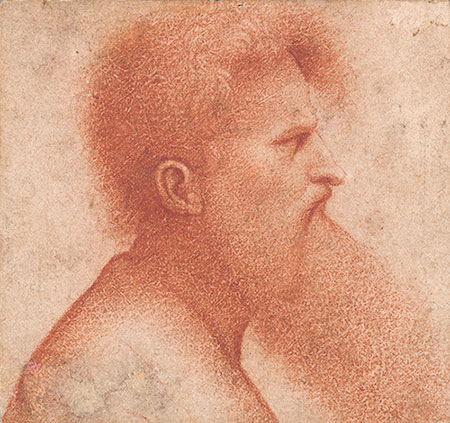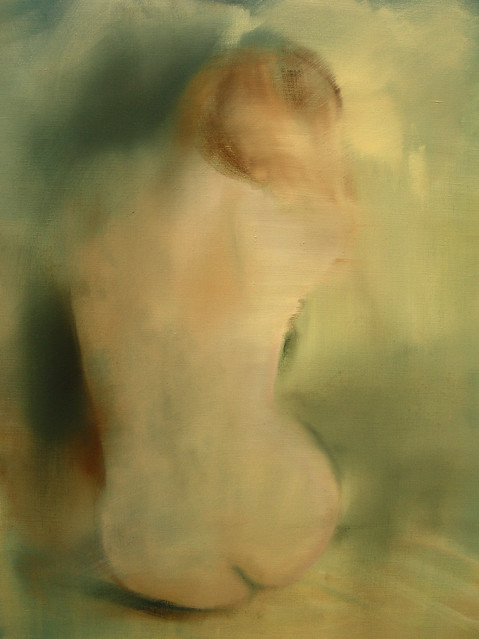by Gregg Chadwick
Intimately viewing the drawings of Michelangelo helps pull the veil of fame off of this towering figure. In spite of the title of the exhibition at the Metropolitan Museum of Art, to give humanity back to artistic gods is no easy feat. The Met has done it twice in fourteen years. First was the 2003 exhibition of
Leonardo da Vinci's drawings and now those of Michelangelo in 2017. Both exhibits have given a sense of hope and human possibility back to viewers in times of struggle and uncertainty.
In its exhibition,
Michelangelo: Divine Draftsman and Designer the Metropolitan Museum has created a temporary museum dedicated to the life, times, and art of Michelangelo. It includes 133 drawings and poems created by Michelangelo that link the artworks to ongoing projects by the artist and his workshop. One of Michelangelo's earliest paintings is included and a small group of his sculptures in marble fill out the show. Also included are drawings by Michelangelo's mentors and artworks by his students and mentees. In a central gallery, a reproduction of the Sistine Chapel ceiling hangs as a canopy above the gallery.
Process and practice
Like his older contemporary
Leonardo da Vinci, Michelangelo was able to create astonishing works of art out of the simplest means of chalk, ink and paper. In Renaissance era Florence, both
Leonardo and Michelangelo learned from established artists. Leonardo was apprenticed to Verrocchio, and Michelangelo was attached to Ghirlandaio's artistic workshop. Complex painting projects such as the Tornabuoni chapel, that Ghirlandaio's workshop was engaged in from 1485-1490 while Michelangelo was there, began with quick idea sketches on paper that were then fleshed out with more involved studies. Apprentices would often pose for these studies. Perhaps the young Michelangelo inspired a figure somewhere on the walls of this chapel? Copying the master's work was also part of the training for young artists. Process and practice were the keys to the growth of a young artist in Renaissance Florence.
The Met's exhibition opens with a group of drawings by Ghirlandaio and then moves on to examples of Michelangelo's studies based on earlier Florentine artists. In many of the works, with quick strokes of the pen coupled with a dense cross-hatching to create shadow and form, Michelangelo sculpts a form out of the paper.
 |
Michelangelo Buonarroti (Italian, 1475–1564)
Study of a Kneeling Man in a Cloak Seen from the Rear
pen and brown ink 11 1/2" x 7 7/8"
Albertina, Vienna
(formerly in the collection of Peter Paul Rubens?)
|
Included with Michelangelo's early studies after the Italian masters is a richly pigmented fantasy based on an engraving by the 15th century German artist Martin Schongauer. ( I wrote about this painting in 2009 when the artwork was first exhibited at the Met as an early work by Michelangelo -
link here.)
 |
Michelangelo Buonarroti (Italian, 1475–1564)
The Torment of Saint Anthony (after Schongauer)
c. 1487–88. Oil and tempera on panel, 18 1/2 x 13 1/4 in.
|
 |
Martin Schongauer
St. Anthony
engraving printed on paper 15th-century - German
|
Emulation and Personal Discovery
The young Michelangelo absorbed the influence of his predecessors into a rapidly developing personal style based on an exploration of the human form. Moving from a faux antique look such as the recently attributed sculpture
The Young Archer to poetically observed life studies, Michelangelo like Leonardo before him learned that "accurate understanding derives from investigation and experience."
 |
Michelangelo Buonarroti (Italian, 1475–1564)
37" x 13 1/4" x 14" marble sculpture ca. 1490
Lent by the French State, Ministry of Foreign and European Affairs
|
In 1504, Michelangelo received a commission by the Republic of Florence for a grand mural of the Battle of Cascina in the Great Council Hall. At the same time Leonardo was working on his own mural for the grand space. Leonardo's chalk drawings for his battle scene are full of expressive movement and grand drama. After viewing Leonardo's powerful designs, Michelangelo, as evidenced in the Met's exhibit, went back to the well and drew a red chalk artwork inspired by the figures of Adam and Eve in Masaccio's fresco in the Brancacci Chapel. Curiously, in this chapel during his apprenticeship, Michelangelo was slugged viciously by a rival artist. His broken nose was never properly reset. Years later he went back to the scene and reclaimed the space and Masaccio's art for his own use.
 |
Michelangelo Buonarroti (Italian, 1475–1564)
Study of Adam and Eve after Masaccio
1504 red chalk, 12 13/16" x 7 3/8 "
|
More Like Flesh than Stone
Moving on from his inspiration, Michelangelo began a series of evocative drawings for the planned Battle of Cascina. Jonathan Jones in
The Lost Battles writes that "time is included in Michelangelo's vision" in these studies. Jones continues - "There is a tragic power to these drawings. He portrays young men in their full strength and beauty and yet shades them with intimations of ruin."
 |
Michelangelo Buonarroti (1475–1564)
Study of the Torso of a Male Nude Seen from the Back
1504 black chalk with lead white gouache highlights on paper 7 11/16" x 10 5/8"
Albertina, Vienna
(formerly in the collection of Peter Paul Rubens?) |
These drawings are sumptuously beautiful, and set the stage for the rest of Michelangelo's artistic life. Michelangelo's touch is all over these works. The use of chalk in many of the drawings, rather than pen and ink, opens up a sensuous physicality that feels more like flesh than stone. Remarkably to me, in the Met's exhibit, a few of the drawings feature a model sporting a hipster worthy mustache who could have walked out of 21st century Brooklyn.
A map of desire seems to be drawn across the back of many of Michelangelo's figures. In the gallery I think of the poetry and art to come - Cavafy, Isherwood, Bachardy, Bacon, and Hockney.
 |
Michelangelo Buonarroti (1475–1564)
Study of the Torso of a Male Nude Seen from the Back
1504 black chalk with lead white gouache highlights on paper 7 11/16" x 10 5/8"
Albertina, Vienna
(formerly in the collection of Peter Paul Rubens?)
|
|
Coming up soon on Speed of Life - Part 2 on "Michelangelo: Divine Draftsman and Designer" at the Metropolitan Museum of Art.
*All photos of exhibit and artwork by Gregg Chadwick 2017













